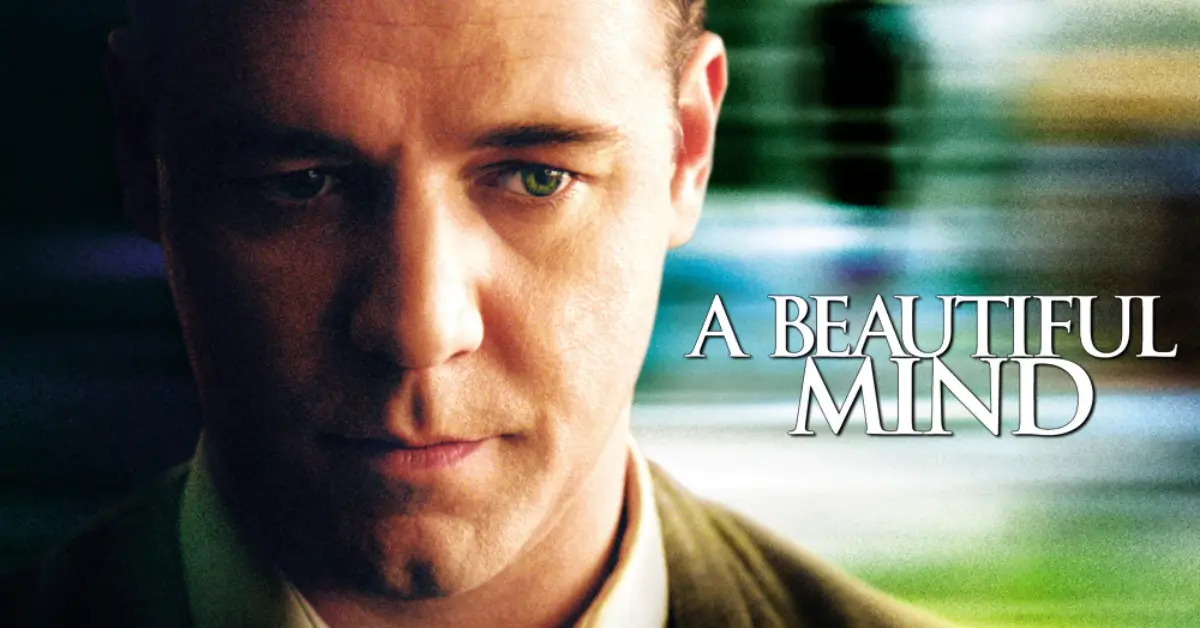A Beautiful Mind: Brilliance, Schizophrenia, and the Journey to Recovery
Few films have captured the complex reality of living with schizophrenia as powerfully as “A Beautiful Mind.” This critically acclaimed film offers viewers an immersive glimpse into the brilliant yet troubled mind of mathematician John Nash, portraying both the devastating impact of severe mental illness and the possibility of recovery. Through its innovative storytelling techniques and compassionate approach, “A Beautiful Mind” stands as a landmark film in cinema’s representation of mental health, challenging stigma and offering hope to those affected by similar conditions.
Thank you for reading this post, don't forget to subscribe!Basic Film Information
Title: A Beautiful Mind
Release Date & Production Year: December 21, 2001 (limited), January 4, 2002 (wide release)
Director: Ron Howard, known for his humanistic approach to storytelling and versatility across genres
Screenwriter: Akiva Goldsman, adapting Sylvia Nasar’s biography of the same name
Main Cast & Characters:
- Russell Crowe as John Nash, Nobel Prize-winning mathematician with schizophrenia
- Jennifer Connelly as Alicia Nash, John’s devoted wife
- Ed Harris as William Parcher, a figment of Nash’s hallucinations
- Paul Bettany as Charles Herman, Nash’s imaginary roommate
- Adam Goldberg as Richard Sol, Nash’s Princeton classmate
- Judd Hirsch as Dr. Rosen, Nash’s psychiatrist
- Christopher Plummer as Dr. Rosen (in some versions)
Genre: Biographical Drama/Psychological Drama
Awards Won: Academy Awards for Best Picture, Best Director, Best Adapted Screenplay, and Best Supporting Actress (Jennifer Connelly); Golden Globes for Best Motion Picture – Drama, Best Screenplay, Best Actor (Russell Crowe), Best Supporting Actress (Jennifer Connelly)
Runtime & Rating: 135 minutes, Rated PG-13 for intense thematic material, sexual content, and a scene of violence
Plot Summary
General Overview
“A Beautiful Mind” follows the life of John Nash from his days as a graduate student at Princeton in the late 1940s through his groundbreaking work in mathematics, his struggle with schizophrenia, and his eventual receipt of the Nobel Prize in Economics in 1994. The film uniquely positions viewers to experience Nash’s reality as he does, before revealing the truth about his hallucinations.
Mental Health Themes
The film primarily explores schizophrenia, focusing on symptoms such as delusions, hallucinations, and paranoia. It also touches on the impact of institutionalization, the side effects of early antipsychotic medications, and the social isolation that often accompanies severe mental illness. Additionally, the film examines the complicated relationship between exceptional intellectual ability and mental health challenges.
Key Turning Points
Several pivotal moments highlight Nash’s mental health journey: his initial descent into paranoid delusions about government conspiracies; the shocking revelation that key people in his life (Charles, Marcee, and Parcher) are hallucinations; his treatment and subsequent struggles with medication side effects; and his eventual development of coping strategies to live with his condition rather than being defined by it.
Ending Analysis
The film concludes with Nash’s acceptance of the Nobel Prize, having learned to live with his schizophrenia without letting it defeat him. Though he acknowledges that he still sees hallucinations, he has developed the ability to recognize and ignore them. This ending offers a message of hope and resilience without minimizing the ongoing nature of serious mental illness, suggesting that even severe conditions can be managed through support, treatment, and personal determination.
Setting & Cinematic Techniques
Filming Locations
Shot primarily at Princeton University and various locations in New York and New Jersey, the film uses authentic academic settings to ground Nash’s story. The psychiatric hospital scenes, filmed at Fairleigh Dickinson University, convey the institutional approach to mental health treatment in the mid-20th century.
Cinematography
Cinematographer Roger Deakins employs masterful techniques to visualize Nash’s subjective experience. The film initially presents Nash’s hallucinations as reality, using warm lighting and clear focus. When the truth is revealed, the visual style shifts, with hallucinations often appearing in slightly different lighting or framing to subtly signal to viewers what Nash himself cannot recognize. The camera work becomes more unstable during paranoid episodes, reflecting Nash’s fractured perception.
Sound & Music
James Horner’s haunting score, featuring vocalist Charlotte Church, emphasizes both the beauty of Nash’s mathematical thinking and the terror of his descent into psychosis. The music creates an auditory landscape that mirrors Nash’s emotional states, from the wonder of discovery to the confusion of psychosis. Sound design strategically employs silence and amplified ambient noise to heighten tension during paranoid episodes.
Acting & Character Portrayal
Lead Actor’s Performance
Russell Crowe delivers a transformative performance as Nash, meticulously portraying the mathematician’s social awkwardness, brilliance, and deterioration into psychosis. Crowe studied Nash’s mannerisms and speech patterns extensively, conveying his conditions through subtle physical choices rather than broad stereotypes. His portrayal shows Nash’s entire arc from arrogant young genius through debilitating illness to hard-won wisdom.
Supporting Cast
Jennifer Connelly’s Academy Award-winning performance as Alicia Nash captures the complex reality of loving someone with severe mental illness depicting both unwavering support and moments of hopelessness. Paul Bettany and Ed Harris excel in roles that require them to be simultaneously charismatic and menacing as Nash’s hallucinations, while Judd Hirsch brings necessary gravitas to the role of Dr. Rosen.
Accuracy & Authenticity
While the film takes significant creative liberties with Nash’s life story (condensing his multiple hospitalizations and omitting his divorce and remarriage to Alicia), Crowe’s portrayal of schizophrenia symptoms is widely regarded as authentic. The film successfully conveys the conviction with which delusions are experienced, making viewers understand how Nash could believe his hallucinations were real.
Mental Health Representation: Strengths & Weaknesses
Psychological Accuracy
The film consulted with psychiatrists to ensure an accurate portrayal of schizophrenia. Its greatest strength lies in allowing viewers to experience Nash’s hallucinations as he does, creating empathy and understanding. The portrayal of antipsychotic medication side effects including cognitive dulling and sexual dysfunction is notably honest for a mainstream film.
Stigmatization vs. Awareness
“A Beautiful Mind” breaks ground by presenting a protagonist with schizophrenia who is neither violent nor defined solely by his illness. By focusing on Nash as a complete person a mathematician, husband, father, and teacher who also has schizophrenia the film challenges common stereotypes. However, some critics note that by emphasizing Nash’s exceptional intellect, the film may inadvertently reinforce the “troubled genius” trope.
Impact on Public Perception
The film significantly increased public awareness of schizophrenia, presenting it as a brain disorder rather than a character flaw or spiritual possession. Many mental health professionals have noted an increase in understanding and empathy following the film’s release. By showing Nash’s successful management of his condition without complete “cure,” the film presents a realistic message about recovery.
Critical Reception & Awards
Critics’ Reviews
“A Beautiful Mind” received overwhelming critical acclaim, with particular praise for Howard’s direction and Crowe’s performance. Roger Ebert awarded it 3.5/4 stars, calling it “an extraordinary accomplishment.” While some critics questioned the film’s historical accuracy, most praised its emotional truth and innovative approach to depicting mental illness.
Audience Reactions
The film resonated deeply with viewers, many reporting increased empathy for those living with schizophrenia. People with lived experience of mental illness and their families have particularly appreciated the film’s non-sensationalized approach. The film became a cultural touchpoint for discussions about schizophrenia, referenced frequently in discussions of mental health in popular culture.
Awards & Nominations
Beyond its four Academy Awards (Best Picture, Director, Supporting Actress, and Adapted Screenplay), the film received numerous honors from mental health organizations for its contribution to destigmatizing schizophrenia. The National Alliance on Mental Illness (NAMI) praised the film for its compassionate portrayal of mental illness.
Cultural & Social Impact
Discussions Sparked
“A Beautiful Mind” generated widespread conversation about schizophrenia, challenging misconceptions and prompting more nuanced media coverage of mental illness. The film helped shift public discourse from fear-based narratives toward stories of possibility and recovery.
Influence on Other Films
The film established a new standard for mental health portrayals in cinema, influencing later works like “The Soloist,” “Silver Linings Playbook,” and “The Theory of Everything” films that similarly balance the challenges of mental or neurological conditions with stories of human achievement and connection.
Mental Health Advocacy
Mental health organizations worldwide have used “A Beautiful Mind” as an educational tool. The film has been screened at awareness events and incorporated into training for mental health professionals. Nash himself, though noting the film’s dramatizations, expressed appreciation for how it increased schizophrenia awareness.
Personal Reflection & Final Thoughts
“A Beautiful Mind” provides profound insight into the experience of psychosis, allowing viewers to understand how hallucinations and delusions can feel absolutely real to those experiencing them. Its narrative technique of revealing the truth about Nash’s hallucinations partway through creates a powerful moment of empathy viewers who believed these characters were real suddenly understand the confusion and disorientation Nash himself must feel.
I would recommend this film to someone struggling with mental health, particularly those affected by psychotic disorders, with the caveat that certain scenes depicting psychiatric treatment may be distressing. The film offers hope without minimizing the ongoing challenges of severe mental illness.
The film could have provided more context about modern schizophrenia treatment approaches, which have evolved significantly since Nash’s experiences in the 1950s and 60s. Additionally, while focusing on Nash’s exceptional mind makes for compelling drama, it might have been valuable to show that recovery is possible for people with schizophrenia regardless of extraordinary intellectual gifts.
Conclusion
“A Beautiful Mind” remains a watershed moment in cinema’s portrayal of severe mental illness. By allowing viewers to experience schizophrenia from the inside out, the film creates unprecedented empathy and understanding. It challenges the notion that mental illness defines a person’s worth or potential, showing instead how Nash learned to live with his condition while still making significant contributions to mathematics.
The film reminds us that behind diagnostic labels are whole people with dreams, relationships, and capabilities. Its lasting impact lies in its humanizing approach to mental illness showing that even conditions as serious as schizophrenia need not be the end of a meaningful life.
What are your thoughts on this film’s portrayal of schizophrenia? Has it changed your perception of what recovery from severe mental illness might look like?

